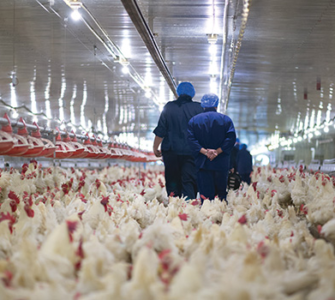Sleuthing to pinpoint source of commercial flock pathogens
By Philip A. Stayer, DVM, MS, ACPV
Corporate Veterinarian
Sanderson Farms, Inc.
One part of my job is sleuthing to identify the probable source of reportable diseases found in our commercial pullet, breeder or broiler flocks. Through the years, it’s provided opportunities to learn something more about different cultures and human behavior as they relate to chicken health.
Almost 20 years ago, I was hired the month after a breeder flock in southern Mississippi was diagnosed with Mycoplasma synoviae (MS). Since MS is a reportable disease, it was my obligation as corporate veterinarian to find out how this poorly transmissible disease got into hens kept behind locked doors.
Mycoplasma spp. are fragile organisms that require moist environments to survive and require almost nose-to-nose contact for transmission. MS did not float onto the farm like some respiratory viruses might. MS was walked onto the farm by a person or maybe another avian.
I started out by interviewing the farm owner and her farmhands. The farm owner home-schooled her only child, so she only left the farm to go shopping and attend church. The farm’s former long-time workers were gone, and the staff was new. The farm owner said she’d asked the new workers if they had chickens or other poultry at their homes. They said no, but the farm owner acknowledged she had not actually visited their residences to confirm.
I obtained permission from the farm owner and farmhands to visit the workers’ homes. I drove through the southern Mississippi countryside in an unmarked but very obvious company mini-van. Upon arriving at the first farmhand’s residence, there were no birds to be seen. The worker was home at the time, but I didn’t press for more information.
Menagerie found
At the second farmhand’s home, I was a bit more persistent. I didn’t see any feathers around, but I was determined to get more information. That was a bit challenging because the residence was a high-rise trailer — elevated 6 feet into the air by concrete blocks, accessible only by rickety wooden steps leading up to the door. I couldn’t get to the door anyway because there was an unleashed pit bull under the trailer growling at me. Finally, the commotion caused by the dog prompted adult residents to come to the door. They told me the farmhand I hoped to speak with lived there but stayed other places as well, so I asked to visit these other places. The residents called a neighbor, who arrived shortly in an old car with serious mileage. I was painfully aware that my shiny, white corporate wheels stood out like a sore thumb.
We caravanned to the first place on the list. The residents confirmed the farmhand stayed there often. They let me walk around to the back of the house where I found a menagerie of turkeys, ducks, multiple colored chickens and heavy white broiler breeders with dubbed toes, combs and trimmed beaks. They graciously promised to allow my return to test their flock for diseases.
On the way to the second place where the farmhand sometimes stayed, the road went from hardtop to gravel to two-ditch dirt roads to just weeds. This journey would have been more appropriate on a tractor or ATV. My professional attire of golf shirt and khakis coupled with my vehicle pegged me as an outsider and probably somebody locals would not want to trust. I decided to stick with testing the first place we found with birds and turned around. Sure enough, after we tested, the heavy broiler-type birds turned up positive for MS.
The farmhand, who was a woman, had been honest with the farm owner when she said there were no birds where she lived. The farm owner, however, neglected to ask if that new farmhand had any recurring poultry contact away from her home. The farm owner also neglected to do due diligence to follow up on what she was told.
The legend of ‘Hot Rod’
This background served me well years later in a whole different state exploring a broiler flock with MS, Mycoplasma gallisepticum (MG) and coryza, which are all commonly found in backyard poultry.
One of my colleagues began the reportable-disease investigation. He interviewed the farm owner and several other folks involved with the property. The farm with disease problems had 12 poultry houses. It was a few miles away from another, 10-house farm the owner maintained. The farmer did not live on either property but had a long-term resident on the affected farm. The on-farm resident spent more time hauling horse hay for the farm owner and only occasionally helped take care of the chickens. He admitted to seeing yard birds during his deliveries through southern Georgia and northern Florida but not at any places where he stopped along the way.
The actual farmhand was known by his nickname: “Hot Rod.” He didn’t live on the farm and told my colleague he had no chickens at his residence. My colleague spent time at the farm but did not visit the farm owner’s residence or the place where Hot Rod lived. He assumed the most likely source of disease was the hay hauler’s possible contact with uncontained poultry.
I returned to the farm the following week in hopes to build a more plausible story. I spoke with the hay hauler and the farm owner; the three of us then then drove to the farm owner’s house. Although a neighbor had guinea fowl, they were contained behind a rail fence with chicken wire. That made it unlikely the farm owner might have tracked back feces or anything else from the guineas to his farm.
The owner, the hay hauler and I next drove out to see where Hot Rod lived. En route, they told me that even though his name was Hot Rod, he didn’t drive. Somebody picked him up at the end of his cul-de-sac every day and returned him in the evening. They also said Hot Rod was well liked by the ladies. They claimed he shared one home with his wife and a girlfriend and had two other girlfriends just around the corner.
Stepped in it
When we drove into Hot Rod’s cul-de-sac, we saw no signs of feathers around his primary residence or anywhere nearby, but when we made the turn onto the block where the other girlfriends lived, we almost ran over a flock of free-ranging banties. Since Hot Rod didn’t drive, he more than likely walked where the banties roamed. He most definitely stepped into something chicken related.
I never did get to meet Hot Rod. I also didn’t get to test the little chickens because the owners weren’t keen on the idea, and there’s no state law that would require testing. We highly suspect, however, that Hot Rod contaminated his footwear and brought disease back to the farm where he worked.
Hot Rod was later taught about making a clean break between what he did in off hours and when he was brought to work. He was provided with rubber boots and coveralls that never left the farm. There has not been a recurrence of MS, MG or coryza on that farm to date.
Experiences early on in my new position taught me a lot to use later in my career. For one, farm workers often have a culture that differs significantly from that of a corporate veterinarian. We corporate types need to be aware of those differences and be sensitive to them. My experiences also demonstrate the need for occasional sleuthing to ferret out the source of poultry pathogens — and the importance of educating farm owners and workers about how to protect commercial poultry from costly diseases.
Editor’s note: The opinions and advice presented in this article belong to the author and, as such, are presented here as points of view, not specific recommendations by Poultry Health Today.
Posted on September 17, 2020
















